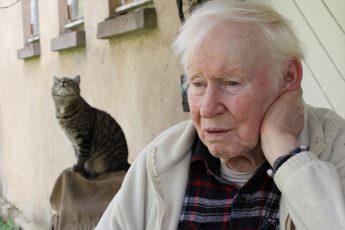
Set in rural Estonia, Mother begins with the investigation of a suspiciously unlikely case of attempted murder. During an armed robbery gone awry, prospective young Lauri makes the mistake of fighting back and, in the process, is shot in the head and left for dead beside an ATM. Doting mother Elsa nurses her comatose son, diligently watchful by his bedside as visitors come and go. But soon enough her humble, domestic regime is upended as the mystery of her son’s shooting unfolds and the truth reveals itself. The residents of the small, backwards town begin to unveil their true nature and life as they know it in the community starts to unravel.
The plot is mischievously misdirected by Kõusaar, oscillating between a darkly comic drama and a sinister murder mystery. The viewer is left to uncover the case and provide himself with more detective work than the baffled policemen it is assigned to. The resultant tone is latent with wickedly black humor and layer upon layer of deceptive character development.
Tiina Malberg’s performance as Elsa is a steady unfastening of her morals and emotions. As the pressures of being a mother, wife and lover become impossible to cope with, she instinctively proves what she is genuinely capable of. Malberg’s diminished style of acting is illustrative of her character’s struggle for happiness, worn down by the lifestyle she has settled for and that there is no respite from. Her movements are restricted to different rooms of the house, where even in the garden the house dominates the background space around Elsa. She is caught between the traditional and outmoded duties expected of her but empowered by her sensibilities as a strong, independent woman. Trapped by her husband, stuck in their loveless marriage and trapped also by her son, forced to be his caretaker, Elsa is morally culpable for his well-being and must permanently stay with him. Elsa’s rituals are confined to that of a desperate housewife. She has an obsessive compulsive need to keep her home clean and tidy, cooking meals for her dazed and withdrawn husband. The school head teacher and Lauri’s boss Aarne brings her fresh flowers every day. While her husband is gardening, fishing or hunting, they make love. Embroiled in a long-term love affair, promising to leave all her family mess behind and elope with Aarne, the spectator’s sympathy for Elsa is short-lived. She struggles to maintain the healthcare for Lauri and begins to feel victimized by her put upon situation. As the guilty feeling of responsibility grows within her, her love for her son appears to dwindle. The maternal ideal of Elsa portrayed at the beginning of the film is forgotten.
The townspeople’s lack of ethics is contagious to the extent that most characters are as deceitful as each other. In one scene, a portly policeman discloses newfound information he has stumbled upon to Elsa. His findings lead him to believe that a significantly large sum of money was withdrawn from her son’s bank account before the crime. Suddenly, characters’ principles are skewed by the promise of monetary gain. The immediate reaction of a number of characters is to ask about the location of the money and whom it was intended for. Rather than to continue looking for the masked assailant, his best friend, his girlfriend and his own mother ransack his bedroom in the hope of discovering the money. Similarly, Lauri’s visitors are quickly turned into reluctant suspects by his mother’s prying eyes and eavesdropping. Perfectly good motives for stealing his savings and murdering come to light. His cheating girlfriend needs money for down payments on their new, shared apartment. His best friend needs to loan more money for his struggling housing business. However, the only response Lauri is capable of is a mismatched blink of his eyes or twitch in his limbs. Here, their greed is presented as just as futile as their interrogations of Lauri.
Pretending to be something you are not is also given a visual manifestation in the setting of the town. Resembling a model version of the real thing, the red rose bushes, white picket fences and pastel colors of the houses evoke a nostalgic rendition of 1950s American suburbia. This mise-en-scene offers an impression of heightened, whitewashed reality. The very flawlessness of its presentation is precisely why its authenticity comes into question. A perfect façade, the atmosphere of the environment is given a subduing effect like the quaint complacency of lifelike figurines in a miniature dollhouse or toy train set. It is as if the filmmaker has created a doppelganger of the real town in order to encapsulate a truly uncanny quality. The abnormality of the setting even bleeds into the inhabitants who themselves share odd gestures and peculiarities disguised as idiosyncrasies. Their performances are simultaneously full of ambiguity and self-awareness, drawing attention to the act they are putting on. One interpretation could be that the intentional manufacturing of such an esoteric setting amplifies the disenfranchisement between residents and their households. It forms an alienated society, out of which is born distrust, betrayal and the hatching of evil schemes.




Leave a Comment